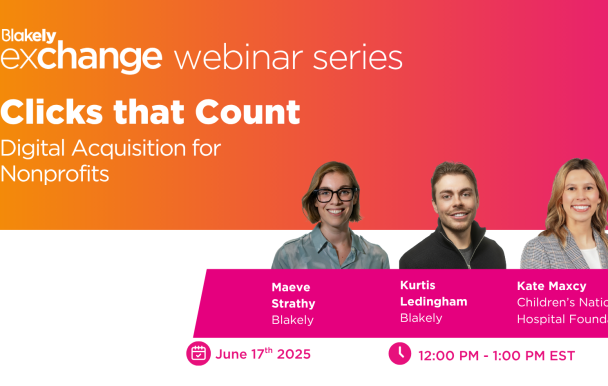
Digital Transformation – what does it really mean for your organization?
Of no surprise to anyone in a charity today, there has been a massive shift to people making gifts online. In fact, this shift has been happening for years, but for the first time ever, we are starting to see that for some not-for-profits the shift has now become the majority of giving, with more than half of people giving online or through a digital platform.
Digital transformation has been a hot topic at Blakely, and what it actually means for organizations as we help them navigate the future of giving. The key is to understand that digital transformation isn’t just shifting to a digital-first lens (which is also important), but actually shifting the mindset of the entire organization, starting at the top. We know this is easier said than done, but this mindset shift will be key in the success of your digital transformation journey.
This can be an overwhelming topic for many, so I want to break down a few of the key components to a Digital Transformation that may help you identify where the critical gaps are in your own organization.
Realizing Digital is Here to Stay
You may be thinking, “of course!” – but one thing that organizations need to realize and actually understand is: the digital world is a communication and messaging platform, but it’s also a transactional platform – a medium where people give.
When COVID hit, organizations who weren’t set up for digital transactions were quickly faced with challenges, with many of them still thinking things may ‘go back to how they were before.’ But I can assure you, we aren’t reverting to cheques in the mail. With what we’re seeing in actual results, your stand-alone mail program will likely not see major growth in the next few years (unless you’re attributing your online transactions back to your direct mail program).
We need to start taking a holistic view of the communications and content you send across channels and understand where people are in their day-to-day communications (i.e. digital) is where they are likely going to communicate/transact with you (i.e. online).
Understanding size doesn’t (always) matter
When it comes to digital transformation, the size of your budget should really have no bearing on your success. Whether you are a national charity or a small grassroots organization, budgets will differ, but it comes down to the journey. An organization that has a 5-million-dollar budget vs. a $3000 budget still use the same channel. Both could be targeting you and both are asking for support.
What levels the playing field? The experience they serve you.
Prioritizing your web presence
Where size does play a factor, however, is in the capacity of your team and resources. So as with anything you want to be successful, you need to prioritize. Gone are the days where putting budget towards digital resources was a ‘nice to have’ – it is now a necessity for the success of your program.
If you’re a smaller organization, you need to find the space, time, and budget to prioritize your web presence in order to make the necessary wins that are needed for digital transformation. And this isn’t about your branding and mission on a flashy webpage. What I am talking about is your entire web presence journey and experience. Which brings me to my next point.
Cleaning out the garage (your website)
As organizations become more ‘integrated,’ a common outcome is websites that have become an overcrowded dumping ground for various departments (program staff, brand, marcomm, fundraising and board) and the output is an overwhelming, confusing, crowded garage of information that is not user friendly.
People process information so quickly in the digital space, that if they come to your website and can’t find what they’re looking for quickly or experience the spinning wheel of doom – they’ll be gone quicker than they arrived.
The key here is to understand that your web presence equals trust. People go to your website to validate you. So, if their experience is poor, and they don’t find the information they’re looking for, you could be losing gifts or a potential donor.
Where do traditional channels sit in this new digital world?
When we talk about the transformation of our organizations to lead with digital, we are often asked the question, “what about direct mail?” We are not suggesting you should abandon your tried-and-true direct mail and offline communications – in fact absolutely not! They are extremely valuable and still make up a large revenue opportunity in fundraising. There is a tangibility aspect to it that, to some, just can’t be replaced. But what I am saying is that you need to give people the choice and fully integrate with digital in order to provide reach and choice and meet people where they are on the journey with you – because if you’re not, you can be assured someone else is.
We know this can be an overwhelming and daunting topic. If anything, here are a few takeaways that you can start implementing today to help aid in your organization’s digital transformation.
- Have the tough conversations – this transformation is a mind shift, and everyone needs to be onboard
- Evaluate your organization’s digital savviness – (take our quick survey here to see how your organization fares in the digital space right now)
- Realize gaps in your reporting – your digital and online experience is only as good as your reporting and your ability to plan and resource this area needs great reporting
- Understand your key audiences & map those journeys out – what actions are they taking in your digital platform? What are they visiting most? What content are they engaging with?
- Prioritize – who gets the space and digital real estate, why, when? This comes back to the cleaning out of the garage and ensuring that you have your journeys in place.
Digital transformation is key to the future of your fundraising and marketing programs so acting now is important. Don’t let another year go by before you make the real change in your systems, planning and campaigning that will lead to new supporters and increased engagement! The time to transform is now!
We know that digital transformation is intimidating – but it doesn’t have to be! I would love to chat more if this is something you have been struggling within your own organization. And if you don’t even know where to start, we are here to help!









